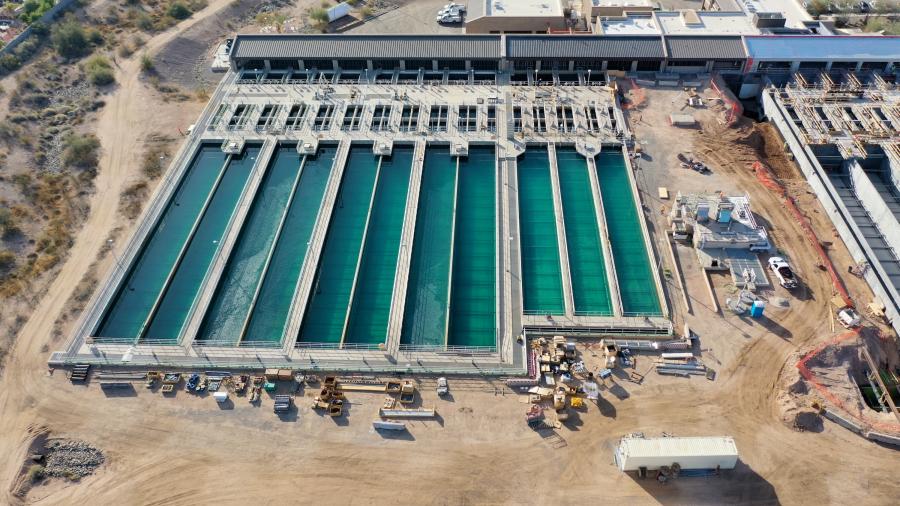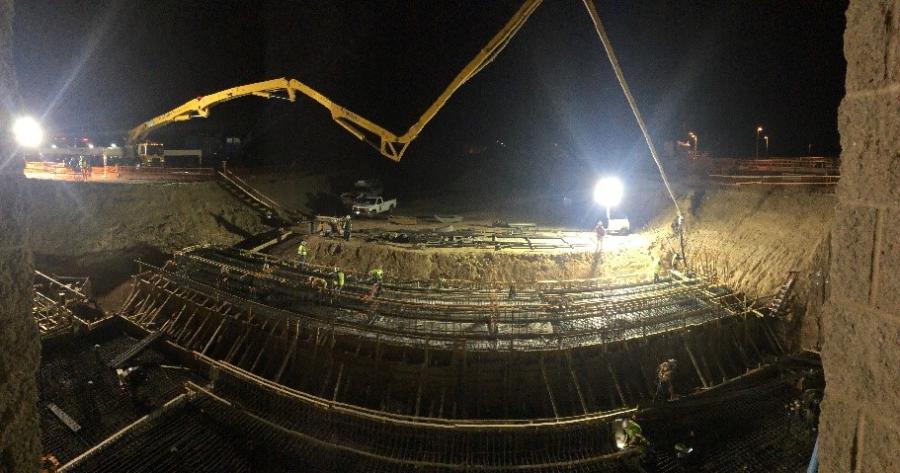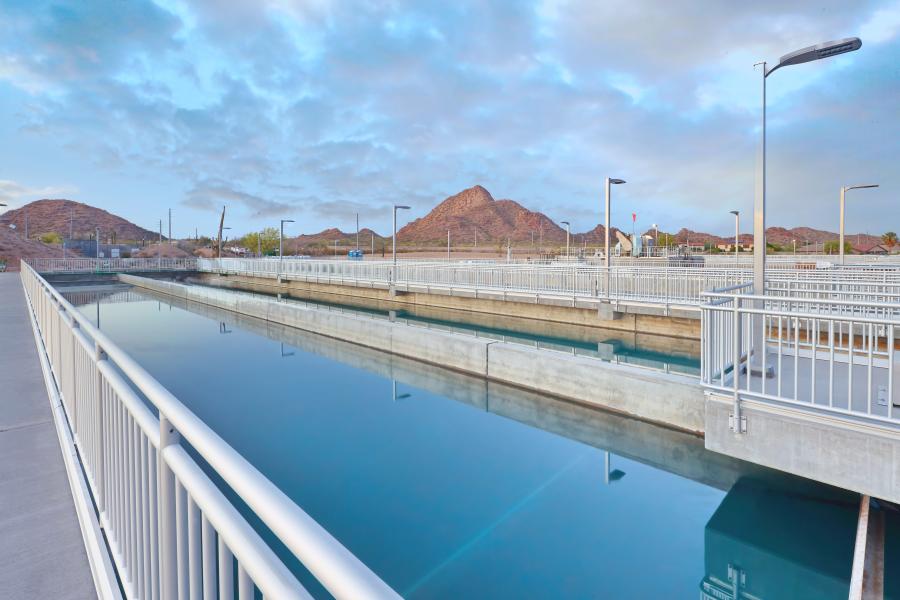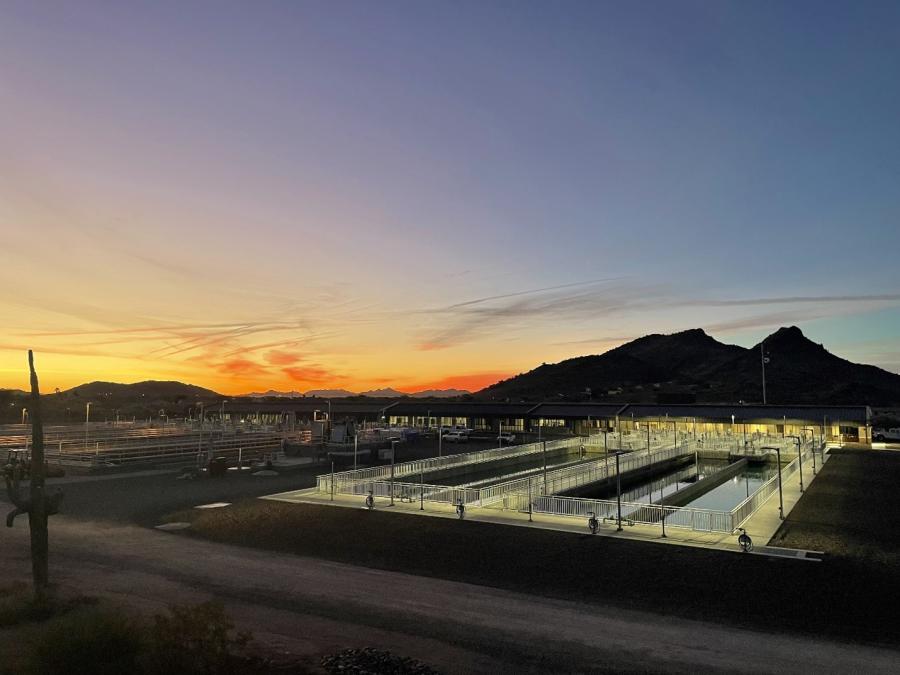McCarthy Building Companies and engineering firm Black & Veatch provided a $65 million upgrade to the Pyramid Peak Water Treatment Plant in Arizona that required the installation of 6,500 cu. yds. of concrete and 7,512 linear ft. of pipe.
(Photo courtesy of McCarthy Building Companies)
Clean water is important for any city. But it is especially essential for desert communities like Glendale and Peoria in the Phoenix, Ariz., metro area. When it came time to update and expand the cities' aging water infrastructure, they turned to contractor McCarthy Building Companies and engineering firm Black & Veatch.
The Pyramid Peak Water Treatment Plant was rated to treat 48 million gallons of water per day (MPD) while operating on a reliable capacity of 39 MGD. The expansion increased the facility to a reliable capacity of 54 MGD. The expansion was needed for adequate water for future growth in Glendale and Peoria.
McCarthy's work on the $65 million project required installation of 6,500 cu. yds. of concrete, 7,512 linear ft. of pipe, equipment installation, HVAC and plumbing.
This crucial piece of infrastructure, along with its multiple moving parts, was constructed in 1985 and expanded in 1999. The current improvements required upgrades to the chemical system, including new pumps, piping and tanks. Substantial electrical upgrades included the replacement of the plant's main motor control centers (MCC) and replacing 1,250 kw and 350 kw generators.
Construction Surprises
As with many construction projects surprises emerged. During the excavation process, the workers discovered a large ductbank, a bank of electrical wires inside of conduits that are encased in concrete. The ductbank was not on any drawings and unknown to everyone involved. Relying on the CMAR method, McCarthy conferred with its partners. From the beginning of the project, the partners had agreed to work together on cost savings, safety, plant operations and quality. Together the team reached a solution.
Removing the ductbank would cost nearly half a million dollars and cost the team valuable time as well.
"We modified the design by raising the slab and the foundation where the duct work was located," said Tim Nicoll, a McCarthy construction manager. "This resulted in considerable cost savings in materials and labor and did not compromise the design intent while water capacity remained the same."
However, this surprise was merely a warmup. The work had been going well with the construction team and put them two months ahead of schedule. The new filters were on the final stages of completion and being prepped to start providing water for the cities. "We were notified by the owners that one of the filters was failing," said Nicoll. "Upon further investigation it was discovered that the underdrains had begun to fail and could allow matter to get through the filter and cause concerns about water quality."
Inspections revealed that four more filters were failing. Meanwhile, the five new filters were finished and were producing the same amount of water that had been shut down due to the filter failures. This allowed the cities to maintain the demand for clean water to their citizens.
While McCarthy was demolishing and replacing the old, failed filters, others began failing as well. Since the team members were well ahead of schedule, they could switch over from putting the final touches on the new filter structure and focus on the filters that were failing. In all, the team replaced 14 failing filters and built 5 new filters on trains 1-4.
The design and construction team also collaborated to provide specialized access structures to large 36-in. drain lines that the cities requested. The cities preferred to have drains that could provide access for divers to enter the backwash channel for future inspections and maintenance of the water treatment plant.
"Water is a precious resource, and our job is to make sure that residents don't have to worry about quality water," said Nicoll. "It's been a pleasure to be able to deliver additional water capacity to the residents of these communities."
Dallas Sweet, senior field engineering manager for Black & Veatch, also recognized the teamwork that paid off in a successful project.
"The project could be declared a model in terms of teamwork and communication. The proactiveness of the entire team provided an outstanding final product that will serve the citizen of Peoria and Glendale for decades to come."
The contractor, engineers and cities collaborated closely on the project using a CMAR (construction manager at risk) delivery method. This cooperation resulted in considerable dollar and time savings for the cities on the design and construction. The time savings turned out to be more critical than expected when the existing filters began to fail during the construction of the new treatment complex. Although these filters were not included in the original plan, McCarthy was able to replace them during construction and keep the water running to Glendale and Peoria. In total 14 filters were replaced and completed within the original budget and project schedule. The three-year job was completed June 2022.
"Water is a precious resource in the Southwest," said Nicoll. "This equipment has been in constant use since its installation. Our team performed the updates while keeping all units operating. It's like performing heart surgery while the patient is still moving around."
The motor control centers (MCC) were at the heart of the project.
"We had to rip the heart out of the plant and replace it with a new heart," said Nicoll. "The MCC provided power to the entire plant. If it were to go down, the city of Glendale and Peoria would be without water. The original design called for the construction of a new building to house the new MCC. We decided instead to install the new MCCs in the same location as the existing MCCs. That saved a couple of million in costs. We were able to demo the old MCCs by installing a temporary MCC in an adjacent area, transfer all the loads, install the new MCCs, transfer the loads back and test them out, all while not interrupting the plant operations and keeping the water running."
The Pyramid Peak Water Treatment Plant contained the construction of a series of structures known as a train. The train contained a rapid mix area where the water enters, mixes with chemicals and begins the sedimentation process.
Particulate matter suspended in the water combines with other materials that create floc, which becomes too heavy to float and settles to the bottom of the tanks. Another step in the purification process removes floc, sludge and sand from the water. In the final stage, water passes through filters that contain anthracite and sand before it is ready for use by consumers.
Each train is able to process approximately 15 MGD of water. CEG
Today's top stories


























